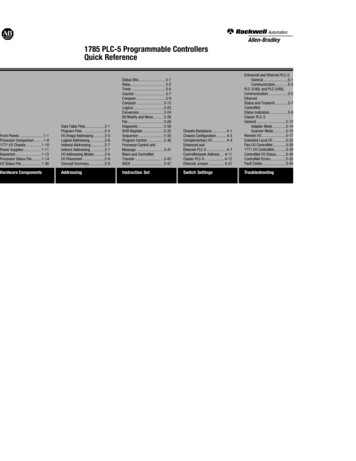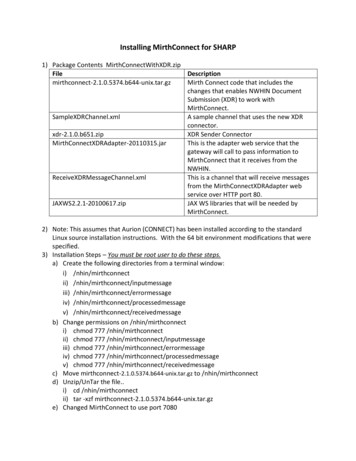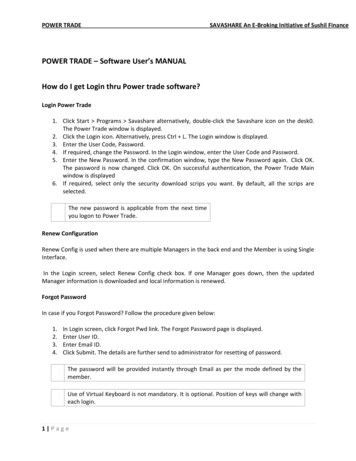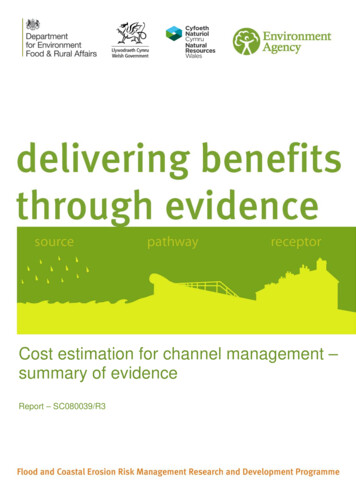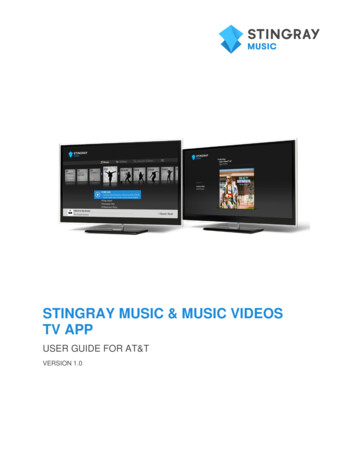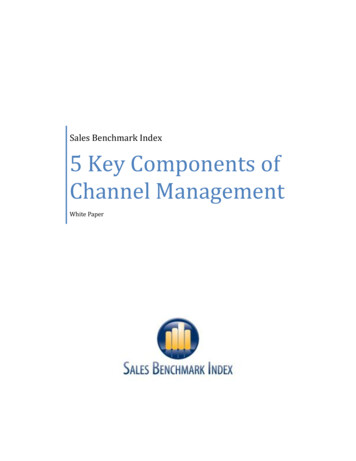
Transcription
Sales Benchmark Index5 Key Components ofChannel ManagementWhite Paper
Unless your company sells exclusively to the End-User of your product, you participate in somedegree of Channel Management. Whether you are selling through Wholesalers, Distributors, Brokers,Dealers, Agents, or Resellers, your task as a channel manager is clear- to provide the programs andstructure to achieve your sales goals without diminishing reputation or upsetting your direct sales force.Whether you are new to Indirect Sales Channels or a veteran, this white paper outlines key criteria forbuilding an effective channel program.A Good Channel Management Program is composed of five components:Alignment to Corporate and Sales StrategyA Defined Partner Selection ProcessA Partner Focused Recruitment PackageAdherence to a Channel Governance ProcessComprehensive Channel Enablement ContentAlignment to Corporate and Sales StrategyThis is a critical and often overlooked part of Channel Development. What are your organizations salescapabilities and limitations? If you’re focused on controlling the total Sales Experience, utilizing IndirectChannel Partners probably isn’t a good fit. Channel management is a good fit for companies who: Want to quickly gain access into a new marketHave a product that is easily bundled with other productsAre looking to limit sales costs and riskNeed sales expertise and technical skills that would require a large investmentNow dive deeper: Do you want to maximize revenues or margin? Do you want expand to new marketsand geographies, or grab a greater market share in existing markets? These answers will help providethe framework for your channel recruitment strategy.Let’s suppose you’ve already established that Channel Partners are best for your current businessstrategy. Now you have to establish formal Channel Partner criteria. Which Channel Partners make themost sense for your business and why?There are two key questions every Sales manager must ask themselves about every product: How does my customer prefer to buy?Notice the key word here: Prefer. Many companies have succeeded by anticipating a customerschanging buying habits. Dell figured out how to sell computers effectively over the internet ascustomers became more comfortable with the product, and retail shops suffered. Similarly, Channel
Managers should make sure that the Channel Partners they are recruiting satisfy their customersbuying requirements. Do they prefer to purchase from Project oriented resellers like SystemIntegrators (SIs) and Original Equipment Manufacturers (OEMs) or Product oriented resellers like ETailors or Value Added Resellers (VARs)? Is this the most efficient channel partner for me to utilize?This is one of the most difficult decisions for a Sales Leader. If I move to a cheaper alternative do mysavings make up for a decrease in revenue? Conversely, if I give up a higher margin to a Channelpartner with more expertise, will I be compensated in extra sales?Any Sales or Channel Manager who wants to design a Channel Management program should surveytheir customers and uncover what their greatest needs are and how they purchase. Here are lists of themost important criteria we’ve captured from a sample Technology company’s End-Customers: System fitSales Representative’s ability to understand my industry and businessSmooth implementationCostOnce you’ve figured out which new Channel Partners make the most sense for your firm, do a thoroughanalysis of your current Channel Partners. Too often, we see Channel Management programs followingthe 80%/20% Rule where 80% of the revenues are generated by 20% of the partners. Find out whatmakes these Channel Partners so effective, and incorporate these values into your Channel PartnerSelection Criteria. Find the companies that don’t produce and remove them from the channel program.Too many Channel Management programs have a flock of unproductive partners that generate minimalsales. These partners aren’t worth the effort.Building a Defined Partner Selection ProcessOnce you’ve determined your Indirect Channel Partner’s context within your selling organization, it’stime to formally establish the criteria. In our 2011 study of channel sales managers, the top quartile ofperformers all had strict selection criteria. Furthermore, firms without formal Channel Partner selectioncriteria experienced up to 30% higher costs in their programs.Below is the process for establishing Channel partner criteria:1.2.3.4.Review the corporate and sales strategy – these are the high level objectives you want to supportConsider your current market position by maturity, vertical, geography, etc.Define your priorities in terms of where to focus channel effortsDefine selection criteria that best support your prioritiesHere is a sample of list of criteria that the top tier channel managers identified in their potential partners: Years in business
Reputation (among customers, other suppliers, peers, trade press)Professional background of key executivesBusiness and management stabilityFinancial strengthOverall revenue and potential revenueLocations, number of active accounts, territory coverageComplimentary lines represented, competitive lines representedKnowledge of marketsEmployee qualityType of market served (horizontal/vertical), number of sales peopleSales people comp plan, marketing aggressivenessInternal support for productPayment policies, price integrityAbility to develop new markets, advertising spend, training programsAccept sales quota, share account informationFuture growth prospects, resource commitmentThese are some examples, but by no means complete. Above all, make sure that their strategy andtarget customers fit with your target market. Too many often, we see Channel Partners and Vendorswith misaligned priorities. Remember, just because your strategy hasn’t changed doesn’t mean yourpartners will all stay on course.Building a Partner Recruitment PackageToo often, we see literature biased towards selecting the right Channel Partner. If only it were this easy.In order to recruit the right Channel Partners, vendors must put together a compelling package. Thereare three main drivers that a Channel Partner looks for when deciding on a vendor:1. Market MomentumChannel Partners are looking for a way to build their business and grow revenues. One easy way todo this is through a strong product that is building a following. Channel Partners will do researchusing Gartner, talking to other vendors, and through their customers. If your product is mature ordeclining, expect a difficult time attracting the channel partners you want.2. Relevance to Target CustomersPartners want a product that is easily adapted into their business, whether it’s a complimentaryproduct to their current offering, or a new product that fits nicely into their Ideal Customer ProfileICP. If the product you are offering partners isn’t in their core customers’ requirements, you may bein for a tough ride.
3. MarginMargin is number 3 because this is what the conversation segues to if you don’t have a strongpresence in the first two categories. All things being equal, margin is the differentiator for manyproducts. However, if you are constantly being squeezed on Margin, it’s because your partners failto see the momentum or relevance to their current audience. The more difficult it will be to sell, thebigger the margin they’ll ask for.Here are some of the typical offerings seen in a solid Channel Recruitment Package:Margin and Pricing The amount of money they can make with us How you handle pricing assistance Quota Attainments Goals and Rewards for MilestonesServices The kind of sales support you will provide (or Sales Engineers) The kind of tech support you will provideMarketing The kind of marketing support you will provide The number of qualified leads you will provide The Media Dollars behind your brand How their Leads and Prospects Are ProtectedTraining Hours devoted to Training Consultants (Technical Training) Hours to Training Sales Reps on Product Features Hours to Sales Process TrainingRemember, in order to make the partnership work there has to be a quid-pro-quo relationship. Forevery Partner that feels neglected based on the amount of revenues they generate for their vendor,there is another partner who gobbles up resources without producing meaningful results. A strongpackage outlines the support you are willing to give, but also sets expectations for production.Adherence to a Channel Governance ProcessOur surveys indicate that over 50% of Vendors begin a Channel Management Program without a predefined governance process. One channel manger recently said, “Once I get the channel partners, thenI’ll worry about the process”. This is a bad idea; once channel partners have been recruited, going backand getting alignment on key issues will be a difficult and prolonged conversation. Furthermore, ifscalability is important, a Channel Governance process is not “Nice to Have”, it is a Must. Many of thecompanies we’ve engaged with have employed an Ad-Hoc system of Channel Partners, with no standardapproach, and highly divergent set of Partners. A tightly defined governance process should assign keyresponsibilities to both the Channel Partner and the Vendor to ensure mutual commitment. It will alsoset expectations for both parties. Lastly, make sure there are established exit criteria should yourpartner fail to meet these requirements.
By creating a proper Channel Governance process, you will avoid one-off relationships, time consumingnegotiations for every new contract, and quell squabbling among competing partners. Below is asample set of criteria. By no means, exhaustive, this should give you a starting point for establishing achannel management program. Far from a laundry list of requirements to join the program, you’llnotice there are many Vendor commitments as well. Make sure to honor your commitments. Alackadaisical approach to the program will result in Channel Partners with equal commitment.Channel Partner Commitments# Of Certified Sales Reps (Step-Up)Revenue Commitment (Step-Up)Pipeline Quota and Close Rate (Step-Up)Dedicated Technical Staff (Step-Up)Quota Attainment StandardsManagement EngagementLeads Generated Per QuarterAnnual Certification RenewalVendor CommitmentsSales Rep/ Engineer Training ProgramsSales Technical SupportDeal Registration ProgramFT Point of Contact ResourceDiscounts for Quota AttainmentManagement EngagementMarket Development Funds (MDFs)Certification/Re-Education ProgramsComprehensive Channel EnablementThe final portion of a great channel management program is establishing Enablement Content.If you’ve established the commitments above that you will make to your Channel Partners, it is time toact on them.There are three types of Channel Process Enablement:1: Process Management2: Knowledge Management3: Performance FeedbackProcess ManagementLead Generation Process: How does your organization decide who gets leads? When does the ChannelPartner get them? When does the direct Sales force? Establishing clear boundaries here will save youheadaches down the road. A good Vendor should also help establish a website that can be directlyembedded into a Partners website for accurate and complete information on the product andimplementation process. The vendor’s own website should have a “Channel Partner Finder” forcustomers interested in contacting a Channel Partner.
Deal Registration: One of the big complaints we here from Channel Partners with competitors in theirsame territory is the low-value providers swooping in at the last minute with deep discounts to stealbusiness after the early partner did all the discovery and solution work. Use deal registration to ensurethat your channel partners have exclusivity over a prospect for a given amount of time, and encouragethem to generate leads.Defined Sales Process: One of the biggest gaps between Channel Partners and the Direct Sales Force islack of a defined Sales Process. Providing and training Partner’s with a customized sales process is one ofthe single biggest ROI Channel Enablement lifts. Understand how their customer buys, and build theprocess around it.Inventory and Warehousing Issues: Keep track of your Channel Partner’s inventory and productdemands to help them optimize their current inventory and shipping costs. Too often the Vendor isblind when it comes to Channel Partner inventory.Implementation Process: Are your channel partners on track to complete their installations? We’veseen Vendor’s reputations tarnished simply because the Channel Partners they recruited weren’tcapable of installing complex solutions. When you buy a Dell computer and it breaks within 2 months,you don’t blame the chip manufacturer. Make sure that you have a program to train the consultants onthis process, and enough resources to aid them should the project deviate from a standard installation.Knowledge ManagementCertification Programs: Because Vendors are giving up direct Control of the interaction of their endcustomer, Certification Programs are one of the more effective ways to ensure that the ChannelRepresentative is competent and knowledgeable about the product he/she is selling.Website Training: Another method of providing knowledge is through a Channel Partner Portal, whereChannel Partners have access to technical product specifications, implementation processes and FAQs,and marketing materials.Vendor Specific Information: There should also be an established website where the vendor can findspecific pricing information on key products and peripherals.Performance FeedbackPerformance Website: This website should include specific Partner performance metrics indicatingpartner performance against goals, peers, and benchmarks for margin/pricing discounts. Real timeperformance management keeps both the partner and the vendor of the overacheivers and the laggardsof the group. This also removes excuses from Channel Managers who site lack of knowledge on hittingthe number.Training Sessions: Include training sessions for Sales Reps, Consultants, and Sales Engineers thatcritique and refine best practices. Award higher margin or product discounts in return for successfulexecution.
Dollars and Discounts Earned: On the vendor’s website, list the number of certified reps and discountsachieved by hitting these requirements. Also list the Market Development Funds committed to thepartner for the year and quarter by these achievements.Customer Satisfaction: The top tier Channel Management programs all solicit feedback from customerson the overall sales and installation process. If you’re partners express concern about a program likethis, it’s a good indication they don’t want you to discover what their customers think.Conclusion:Although this list is comprehensive, some of the examples are specific to certain industries and verticals.A best practice for any channel manager is to establish the customers end user needs, select channelpartners who can deliver, and build a program for their continued success. Failure on any one of thesetiers results in a chaotic channel management program and wasted resources. The best channelmanagement programs have stringent goals, benefits, and are easily scalable. They also enable thePartner to succeed with the proper commitment. Learn more about Channel Management bestpractices by contacting Sales Benchmark Index directly.Resource Blog hitepaperhttp://www.salesbenchmarkindex.com/?Tag Channel Management Strategy
structure to achieve your sales goals without diminishing reputation or upsetting your direct sales force. Whether you are new to Indirect Sales Channels or a veteran, this white paper outlines key criteria for building an effective channel program. A Good Channel Ma
